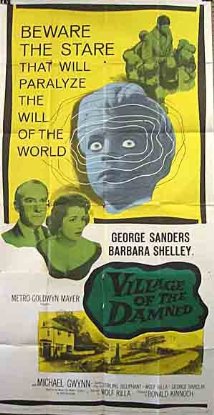The best way to watch this movie is ignorantly. Go to Netflix now, put the movie at the top of your queue and watch it when it arrives. Read about it later. If you enjoy sci-fi classics like “The Day the Earth Stood Still” and “Them!”; if you love the Britishness of the Hammer horror pictures; if you prefer a well-told story, rich suspense, sympathetic characters and black-and-white photography to special effects, color and gore, you will want to see this film right away.
The movie begins in Midwich. We meet the scientist Gordon Zellaby having a telephone conversation. Mid-sentence he passes out. At the same moment, every single person and animal in town has passed out just as suddenly; some unknown force has put all the inhabitants of Midwich to sleep. When the army gets involved, we discover this force has precise boundaries. One soldier, after being lassoed around the waist, walks past the boundary, loses consciousness and immediately revives when his fellows pull him out of the infected area. A few hours later, this strange force disappears and everyone wakes up. The mystery remains unsolved for weeks, but it has a sequel. All Midwich women of childbearing age are unaccountably pregnant.
Watching this science-fiction movie paired with almost any modern one demonstrates how storytelling has devolved as special effects have advanced. It also demonstrates how one simple effect can be more memorable than a thousand complex ones. I happened to see this just before watching “The Forgotten” (2005), a stupid movie with expensive effects; but not of those expensive effects is as potent as this movie’s signature device. When the blonde-haired Midwich children wreak psychic havoc, the picture freezes and their eyes glow. That inexpensive trick shot is worth the millions blown on “The Forgotten.”
Another nice effect: George Sanders. He plays the hero, Gordon Zellaby, a scientist who becomes a dubious father to one of the Midwich freaks. Sanders plays rogues in almost every other movie, but here he is sweet-natured and convincingly so; he betrays not a shadow of his usual cynicism. Were this his only surviving film, one would think he was born to play kindly old men. The excellent cast has one other outstanding performance by Martin Stephens, who plays Sanders’s cold-hearted “son.” Would you be surprised to learn his voice was dubbed by a female actress specializing in children? I was surprised to learn it wasn’t. That is the boy’s own eerily precise diction.
Special praise must also go to the director and photographer, Wolf Rilla and Geoffrey Faithful, who give the movie the detached air of a documentary. The script, credited to Stirling Silliphant, George Barclay and Rilla, is an excellent adaptation of a fine book, “The Midwich Cuckoos” by John Beynon Harris. Fans of this movie will want to read it. The book has many enjoyable details that were necessarily and wisely cut from the adaptation. To note one difference, the children in the movie are psychically linked: what one knows they all know. But in the book, the boys are psychically linked with the boys, the girls with the girls; but there is little or no link between the two sexes. The reasons for this are fascinating.
I haven’t seen the John Carpenter remake, and I don’t want to. What would the ideal remake of this film look like? It would look like the original: black-and-white, set in the late fifties, cast with Brits and scripted with the same restraint. Maybe modern resources could add a piquant touch or two; it would be amusing to see all those sheep fall asleep in the opening scene. Oh, and that awful model shot of the school could be replaced. Otherwise, we have the film we want, so why remake it?

